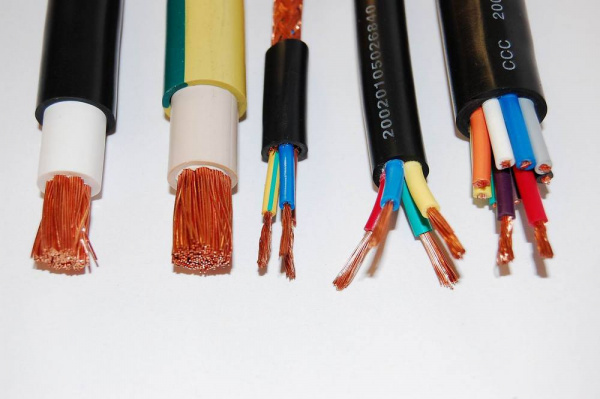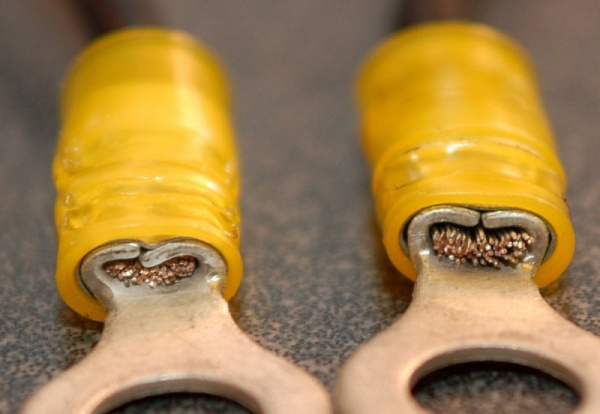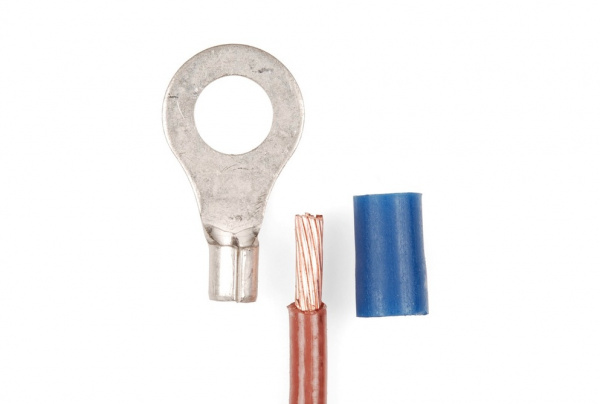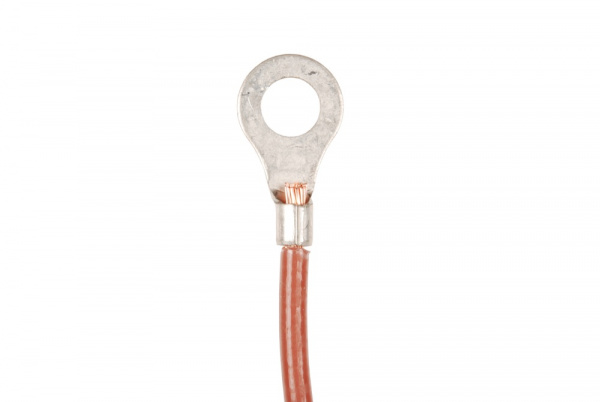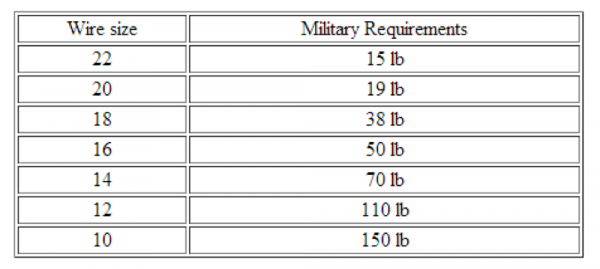Working with Wire a learn.sparkfun.com tutorial
Introduction
When someone mentions the word wire, they are more than likely referring to a flexible, cylindrical piece of metal that can vary in size from just a few millimeters in diameter to several centimeters. Wire can refer to either a mechanical or electrical application. An example of a mechanical wire could be a Guy-wire, but this this guide will focus on electrical wiring.
Inside a stranded wire
Electrical wire is a backbone of our society. There is wire in houses to turn on lights, heat the stove, and even talk on the phone. Wire is used to allow current to flow from one place to another. Most wires have insulation surrounding the metallic core. An electrical insulator is a material whose internal electric charges do not flow freely and, therefore, does not conduct an electric current. A perfect insulator does not exist, but some materials such as glass, paper and Teflon, which have high resistivity, are very good electrical insulators. Insulation exists because touching a bare wire could allow current to flow through a persons body (bad) or into another wire unintentionally.
Recommended Reading:
Here are some topics you might want to explore before reading about wire:
Stranded vs Solid
Wire can come in one of two forms, stranded or solid core.
Various colors of solid core wire
Solid wire is composed of a single piece of metal wire, also known as a strand. One very common type of solid wire is known as wire wrap. Stranded wire is composed of many pieces of solid wire all bundled into one group.
Various colors and sizes of stranded wire
Stranded wire is much more flexible than solid wire of equal size. For this reason, stranded wire is used when the wire needs to move around frequently, in a robot arm for example. Conversely, solid wire is used when little or no movement is needed, such as prototyping circuits on a breadboard. Using solid core wire makes it easy to push the wire into a breadboard. Trying to use stranded wire on a breadboard can be very difficult, as the strands want to separate as they are pressed in.
Wire Thickness
The term ‘gauge’ is used to define the diameter of the wire. The gauge of a wire is used to determine the amount of current a wire can safely handle. Wire gauge can refer to both electrical and mechanical. This tutorial will only cover electrical. There are two main systems for measuring gauge, American Wire Gauge (AWG) and Standard Wire Gauge (SWG). The differences between the two are not critical to this guide.
An approximate scale of several different gauges of wire
The amount of current that a wire can carry depends on a few different factors, for example the composition of the wire, wire length, and condition of the wire. In general, thicker wire can carry more current.
An approximate wire thickness to current capability chart
Here at SparkFun we typically use 22 AWG wire for prototyping and breadboarding. When using a breadboard, the solid core is perfect because it fits nicely into the breadboard holes. For other prototyping/building involving soldering, the stranded core is #1, just be sure not to let too much current run through a single wire, it will get hot and could melt!
SparkFun carries a variety of both solid and stranded 22 AWG wire. Check it out!
How to Strip a Wire
Safe, durable electrical connections begin with clean, accurate wire stripping. Removing the outer layer of plastic without nicking the wires underneath is critical. If a wire does get nicked, the connection may break or an electrical short may occur.
No nicks or gouges. These wires have been properly stripped
The Tool
A simple manual wire stripper is a pair of opposing blades much like scissors. There are several notches of varying size. This allows the user to match the notch size to the wire size, which is very important for not damaging the wires.
Warning: Many wire strippers found at the hardware store do not strip small gauge wire (22 to 30). When getting into prototyping, be sure to get a tool that is capable of stripping 22 AWG and smaller. Being able to strip very small 30 AWG wire (also known as wire wrap wire) is a plus.
Although a knife would also strip the wires, it may also damage the wire by nicking the metal or cutting into it. Using a knife to strip wire is also really dangerous! The knife can easily slip and cause wicked injuries.
Stripping the Wire
By simply squeezing the handles about ¼" from the end of the wire or the desired length, using the correct notch on the tool, and then twisting it slightly, the insulation will be cut free.
Then by pulling the wire strippers towards the end of the wire, the insulation should slide right off of the wire.
Tips, Tricks, and Hints
It is important to match the size of wire to the correct notch in the stripper. If the notch is too large, the wire will not get stripped. If the notch is too small, there is a risk of damaging the wire. Using an undersized notch means the strippers will close too far, digging into the wire underneath. With stranded wire, the tool will cut off the outer ring of wires, decreasing the total diameter of wire and reduce the strength of the wire. A nick in solid core wire will severely reduce the strength and flexibility of the wire. The likelihood of the wire breaking upon being bent increases significantly.
This wire was not stripped properly, there are gouges and missing strands
If a wire does accidentally get a nick in it, the best plan of action is to cut the damaged part of the wire off and try again.
How to Crimp an Electrical Connector
An electrical connector is a device for joining electrical circuits together using a mechanical assembly. The connection may be temporary or serve as a permanent electrical joint between two wires.
There are hundreds of types of electrical connectors. Connectors may join two lengths of wire together or connect a wire to an electrical terminal.
The Tool
The word crimping in this context means to join two pieces of metal together by deforming one or both of them to hold the other. The deformity is called the crimp.
The metal has been deformed to pinch the wire and hold it in place
In order to crimp connectors onto a wire, a special tool is required. Note: Pliers are not crimpers! Neither are hammers, vises, needle nose pliers or flat rocks. A good crimper when used correctly will make a cold weld between the wire and the barrel of the connector. If you were to cut a well executed crimp in half you would see a solid form of wire and connector. Using the wrong tool will not achieve a good crimp!
Why is this level of perfection required? A poor crimp leaves air pockets between the wire and connector. Air pockets allow moisture to collect, moisture causes corrosion, corrosion causes resistance, resistance causes heat, and may ultimately lead to breakage.
The top crimper will give better results, however the bottom one works just fine too
There are several different styles of crimpers available. The best crimper, shown on the top, has a built in ratchet. As the handles are squeezed together, it will ratchet and prevent the jaws from opening back up. When enough pressure has been applied, the ratchet will disengage and release the crimped part. This ensures enough pressure has been applied. This style of crimper also has a wide jaw to cover more surface area on the connector.
The crimping tool on the bottom can achieve nearly the same results, although it requires the user be be much more vigilant. This style of crimper is generally less sturdy. Attention must be given while crimping to ensure the jaws are lined up properly on the connector. Misalignment will cause a less than desirable crimp connection. Over time, wear and tear from normal usage can also cause the jaws to become separated and not close fully. Generally, squeezing it as hard as possible will be sufficient.
Crimp the Connector
There are several arguments for and against using solid core wire with crimp connections. Many believe crimping to solid core wire creates a weak point in the wire, which can lead to breakage. There is also a greater chance for a crimp connection to come loose with solid core wire because the wire will not conform to the terminal as well. If you must use solid core wire, it is a good idea to solder the wire in place after you crimp it.
First, the correct size wire must be chosen for the terminal size, or vice versa. Next, strip the wire. The amount of exposed wire should be equal to the length of the metal barrel on the connector, usually around ¼” or so. If the stripped wire fits up into the metal portion of the barrel with little or no free space, the connector is the right size.
A good length of wire to barrel ratio
Remember: If the wire does not fit in the barrel, or is excessively loose, the wrong size of either wire or connector was chosen.
The wire should then be inserted until the insulation on the wire touches the end of the barrel.
Good: The wire is sticking past the barrel just a little
The wire and terminal are then inserted into the crimper. The color of the terminal’s insulation needs to be matched with the same color on the crimping tool. So if the terminal’s insulation is red, use the spot marked by the red dot on the crimpers. Alternatively, if the crimper does not have color markings, use the gauge markings on the side.
The terminal should be sitting horizontal with the barrel side up. The tool is then held perpendicular to the terminal and placed over the barrel, nearest to the ring (or other connection type). To finish the crimp, the tool is squeezed with a considerable force. In general, it is almost impossible to ‘over crimp’ a connection.
After the crimp is completed, the wire and connector should still hold together after trying to pull them apart with great force. If the connection can be pulled apart, the crimp was not done correctly. It is better to have the crimp fail now, versus after it has been installed in its application. Below is a military spec chart for crimped connections.
Common Mishaps
Wrong size connector for the wire or wrong size wire for the connector.
Bad crimp. Connector was too small for the gauge of wire chosen.
Be cautious not to strip too much insulation off.
Too much insulation has been stripped off, too much bare wire exposed
It is also worth mentioning that, while not necessarily harmful, The wire should not be protruding too far past the barrel. If this happens, trimming the wire is recommended.
The excess bare wire should be trimmed off
Going Further
You should now be familiar with electrical wire and how useful it is in the world of electronics. Whether you’re prototyping, reworking, or building a final product, electrical wire can be your best friend.
Here are some other tutorials you can explore that involve electrical wire.
- Wire is the most basic element when creating your own circuits.
- Unsure which connectors to use? Have a look at Connector Basics to get what you need!
- Want to start prototyping? Check out Breadboards to get going!
learn.sparkfun.com |CC BY-SA 3.0 | SparkFun Electronics | Boulder, Colorado


